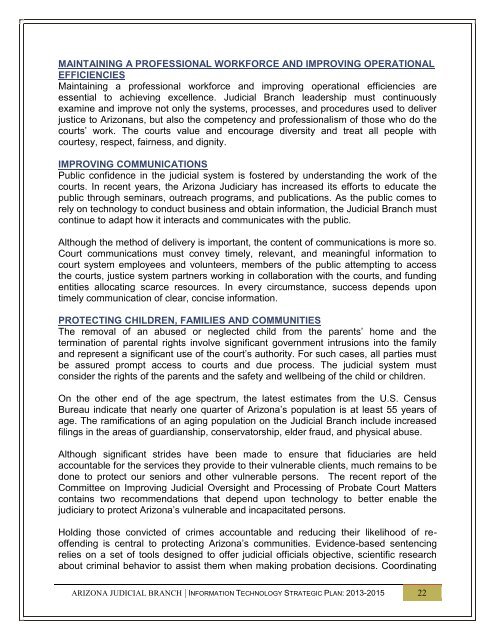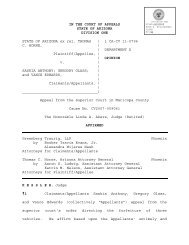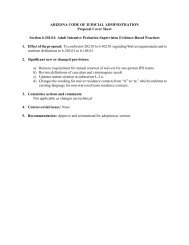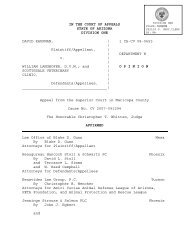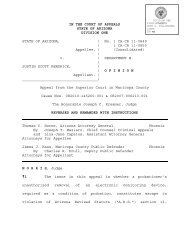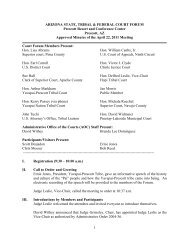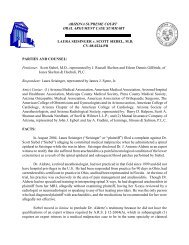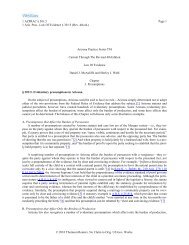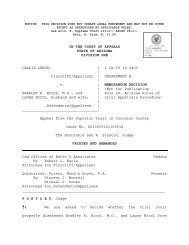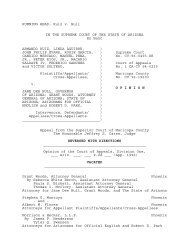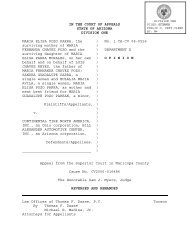Print Version - Arizona Judicial Department
Print Version - Arizona Judicial Department
Print Version - Arizona Judicial Department
Create successful ePaper yourself
Turn your PDF publications into a flip-book with our unique Google optimized e-Paper software.
MAINTAINING A PROFESSIONAL WORKFORCE AND IMPROVING OPERATIONAL<br />
EFFICIENCIES<br />
Maintaining a professional workforce and improving operational efficiencies are<br />
essential to achieving excellence. <strong>Judicial</strong> Branch leadership must continuously<br />
examine and improve not only the systems, processes, and procedures used to deliver<br />
justice to <strong>Arizona</strong>ns, but also the competency and professionalism of those who do the<br />
courts’ work. The courts value and encourage diversity and treat all people with<br />
courtesy, respect, fairness, and dignity.<br />
IMPROVING COMMUNICATIONS<br />
Public confidence in the judicial system is fostered by understanding the work of the<br />
courts. In recent years, the <strong>Arizona</strong> Judiciary has increased its efforts to educate the<br />
public through seminars, outreach programs, and publications. As the public comes to<br />
rely on technology to conduct business and obtain information, the <strong>Judicial</strong> Branch must<br />
continue to adapt how it interacts and communicates with the public.<br />
Although the method of delivery is important, the content of communications is more so.<br />
Court communications must convey timely, relevant, and meaningful information to<br />
court system employees and volunteers, members of the public attempting to access<br />
the courts, justice system partners working in collaboration with the courts, and funding<br />
entities allocating scarce resources. In every circumstance, success depends upon<br />
timely communication of clear, concise information.<br />
PROTECTING CHILDREN, FAMILIES AND COMMUNITIES<br />
The removal of an abused or neglected child from the parents’ home and the<br />
termination of parental rights involve significant government intrusions into the family<br />
and represent a significant use of the court’s authority. For such cases, all parties must<br />
be assured prompt access to courts and due process. The judicial system must<br />
consider the rights of the parents and the safety and wellbeing of the child or children.<br />
On the other end of the age spectrum, the latest estimates from the U.S. Census<br />
Bureau indicate that nearly one quarter of <strong>Arizona</strong>’s population is at least 55 years of<br />
age. The ramifications of an aging population on the <strong>Judicial</strong> Branch include increased<br />
filings in the areas of guardianship, conservatorship, elder fraud, and physical abuse.<br />
Although significant strides have been made to ensure that fiduciaries are held<br />
accountable for the services they provide to their vulnerable clients, much remains to be<br />
done to protect our seniors and other vulnerable persons. The recent report of the<br />
Committee on Improving <strong>Judicial</strong> Oversight and Processing of Probate Court Matters<br />
contains two recommendations that depend upon technology to better enable the<br />
judiciary to protect <strong>Arizona</strong>’s vulnerable and incapacitated persons.<br />
Holding those convicted of crimes accountable and reducing their likelihood of reoffending<br />
is central to protecting <strong>Arizona</strong>’s communities. Evidence-based sentencing<br />
relies on a set of tools designed to offer judicial officials objective, scientific research<br />
about criminal behavior to assist them when making probation decisions. Coordinating<br />
ARIZONA JUDICIAL BRANCH | INFORMATION TECHNOLOGY STRATEGIC PLAN: 2013-2015 22


